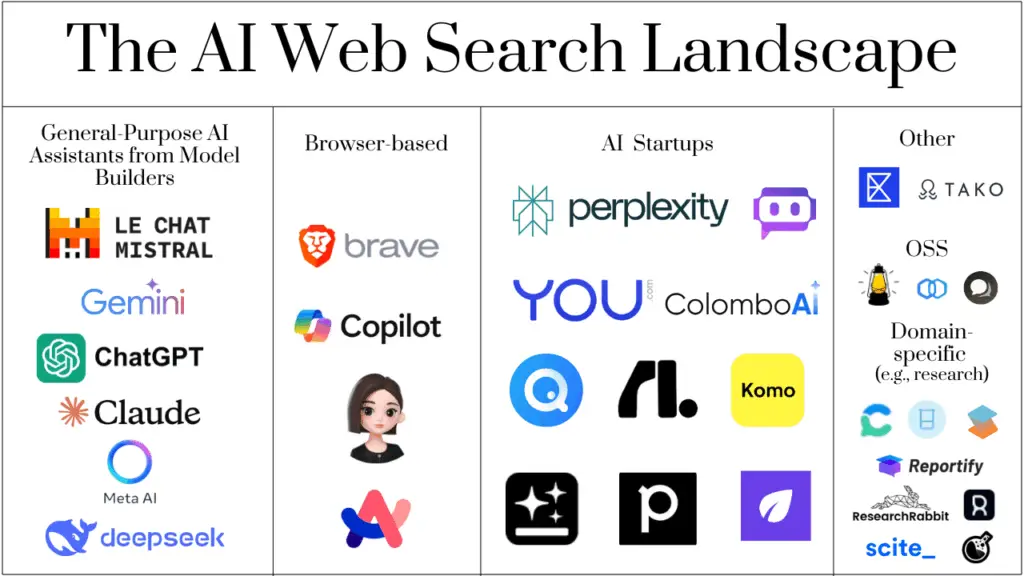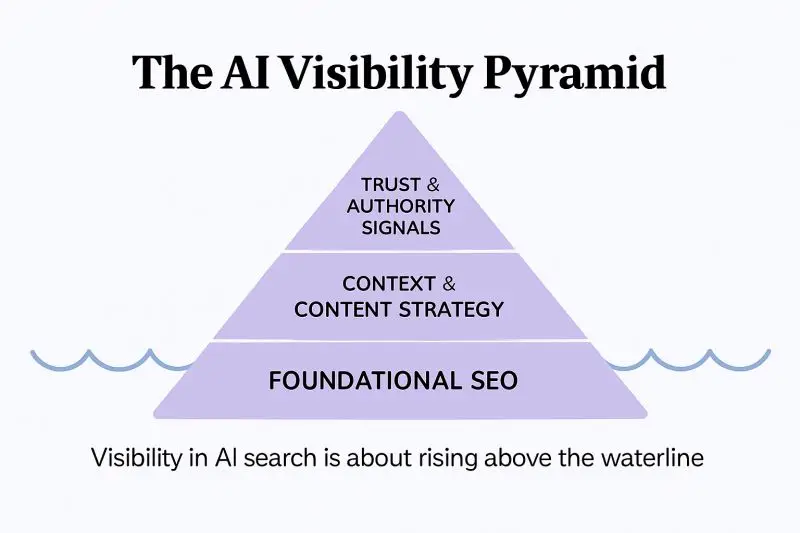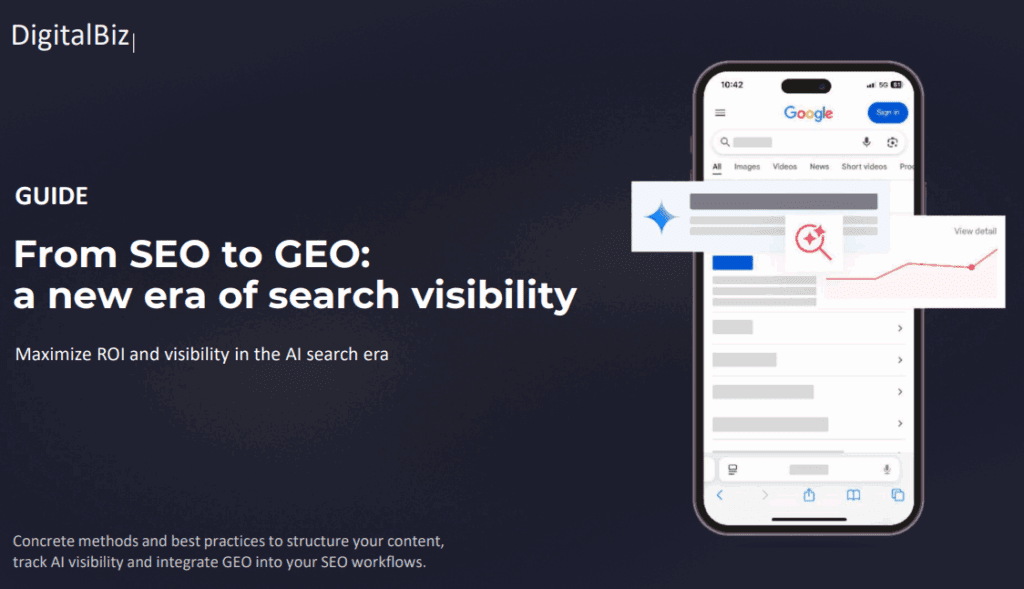SEO To GEO: Strategy ToolBox
- Home
- SEO To GEO: Strategy ToolBox
Table of Contents
Check Your Brand Visibility To AI Search Engines
What Is An AI Brand Visibility Report?
Survival in the AI search era means adapting quickly—by diversifying traffic sources, building direct audience relationships, and upskilling teams for visibility in a world where AI is the new search interface
Brand Visibility Reports are designed to analyze your brand’s visibility in generative AI tools used for search like Google AI Overviews, AI Mode, ChatGPT, Bing CoPilot, Perplexity and others. You can do this for free—see the details below—but remember, ongoing measurement is important to track and improve your AI brand visibility strategy.


Which AI Brand Visibility Report To Use?
Start benchmarking LLM and AI visibility now, even if tools are imperfect; the industry will soon converge on new metrics.
Measurement and optimization will likely focus on LLM/AI visibility, with a shift from traffic to revenue and engagement as key performance indicators. Check out the reports below.
Choose HubSpot AI Search Grader for a free and user-friendly starting point and simple benchmarking. Use SEO2LLM for ongoing visibility optimization with both free and paid plans. For professional teams needing in-depth ongoing competitor monitoring and analytics, RankScale offers detailed dashboards and scalable pricing.
HubSpot is the most accessible for all users, with strong reporting for free and no usage limits. Its primary value is in simplicity and broad, actionable insights for anyone wanting a snapshot of their standing in generative AI search.
SEO2LLM is proactive and action-focused: it gives more in-depth recommendations and tracks performance changes, with premium plans unlocking more detailed dashboards and continuous monitoring.
RankScale stands out for teams needing more granular tracking, historical comparison, competitor insights, and support for large-scale, ongoing operations. It does not have a free tier, but its paid tiers offer extensive monitoring functions.
AI Brand Digital Visibility WorkFlow Strategy
Delivering AI Brand Visibility
AI-driven answer summaries like “AI Overviews” have moved from a curiosity in 2024 to a major disruption in 2025. These features, now present in 13-19% of Google searches (and likely more for longer-tail queries), deliver direct, AI-generated responses at the top of results pages—often negating the need for users to visit source websites. As a result, publishers and brands are experiencing traffic declines of 15% to 45%, with some niche publishers reporting drops up to 70%.
Search optimization is no longer one-size-fits-all as AI-driven search innovations fundamentally reshape traditional SEO practices by prioritizing direct answers, conversational interactions, and AI-friendly content. Businesses need to find new ways of delivering AI brand visibility.


A workflow for balancing traditional SEO with AEO/GEO
Traditional SEO will not disappear overnight but a hybrid future beckons: businesses must balance traditional SEO with AEO/GEO to maintain visibility in an AI-dominated search ecosystem.
Businesses need holistic strategies that combine content planning, multi-format creation, AI-specific optimization, and performance tracking; such as the example given below:-
MarketMuse, AI EngineBoost, SEO2LLM, and RankScale offer a proven, end-to-end workflow that helps small businesses seamlessly shift from traditional SEO to AI-driven search—streamlining the process and minimizing AI risk as all processes are tried and tested.
MarketMuse’s AI-driven platform helps you identify high-value topics and analyze competitor gaps to create data-backed content plans. By pinpointing gaps in your existing content, you can build topical authority, a critical signal for AI engines prioritizing expertise.
AI EngineBoost transforms your content strategy into AI-friendly formats, distributing it across 300+ high-authority platforms and social networsk. It ensures your content aligns with AI engines’ preferences for diverse, EEAT-compliant sources.
SEO2LLM ensures your content is perfectly structured for AI engines and LLM comprehension, bridging the gap between traditional SEO and the new world of AI-driven search. Maximize your brand’s visibility and relevance in AI-powered results.
RankScale closes the loop by providing quantifiable metrics to measure the impact of the workflow. Track your brand’s visibility across AI platforms, benchmark against competitors, and receive real-time optimization insights to maximize AI search presence.
Check How AI Is Being Used In Your Business
The Rundown: Microsoft just analyzed 200,000 conversations with Bing Copilot to reveal the jobs and tasks people are currently delegating to AI, investigating which occupations will be most and least impacted by the rapidly transforming workforce. |
The details: |
|
Why it matters: This data shows a practical link between what AI excels at and where those skills translate directly to in the job market, and many of the highest exposures are already facing those massive disruptions. Plus — despite the huge advances with robotics, it appears physical and hands-on jobs are still the safest bet (for now). How to use the report: Tasks and occupations are listed in the report on the basis of how they relate to or use AI. Cross reference these against common tasks and staff titles in your business to get an idea of how AI is most likely used. For example, What decisions are likely delegated to AI in your business? |
E-BOOK: From SEO to GEO – A New Era of Search Visibility
Concrete methods and best practices to structure your content, track AI visibility and integrate GEO into your SEO workflows.
Why SEO alone is no longer enough
Over the past 30 years, SEO has shaped how brands appear online — through keywords, backlinks, and technical optimization. But
generative AI is rewriting the rules.
With tools like ChatGPT, Perplexity, Gemini, or Google AI Overviews, users no longer browse through a list of links. They get synthesized answers, drawn from high-authority content.
This shift calls for a new strategy: generative engine optimization (GEO). GEO doesn’t replace SEO — it complements it by helping your content get selected, understood, and cited by AI systems.
In this guide, we’ll explore how GEO works, how to integrate it into your strategy, and how to make your content visible across both search engines and generative platforms.

